CIDF-WSN: A Collaborative Interest and Data Forwarding Strategy for Named Data Wireless Sensor Networks
Abstract
:1. Introduction
- Layered Architecture: CIDF-WSN puts forward a layer-based architecture for Interest and Data packet forwarding for resource-constrained Named Data Internet of Things (IoT).
- NFIB for single radio WSN nodes: We extend the existing NDN architecture and propose a new table named NFIB which enable the node to select the optimal next forwarder in Interest forwarding.
- Interest packet processing: CIDF-WSN develop an efficient Interest processing mechanism to avoid Interest packets loss and to update the cost associated with the NFIB entries.
- Data packet recovery: CIDF-WSN presents a robust Data packet recovery mechanism to avoid Data packet loss when the designated lower layer node in the breadcrumb path fails to forward a packet.
- Interest Cache Table (ICT) and Temp Cache Table (TCT): we devise an Interest Cache Table (ICT) and Temp Cache Table (TCT) to avoid transmission(s) losses.
2. Challenges in Address-Based Communication Architecture
- Scalability: The current WSNs deployment utilizes the conventional address-based solution(s) which may induce the efficiency and scalability issues. For instance, extracting the PH value of soil from a single sensor in the agricultural field requires the address and type information of each sensor (i.e., the mapping of address with the content). Therefore, managing the enterprise level deployment of nodes becomes a significantly complex as well as time-consuming operation.
- Data Unavailability: Considering the low battery and low memory constraints of WSN nodes, the Data unavailability issue may arise. To cope with data unavailability problems, an in-network caching-like solution is required. Unfortunately, the conventional IP architecture provides no support for in-network caching [18].
- End-to-End connectivity: In most IoT applications, the consumers are interested in updated Data rather than the location of the producer of that specific Data item [19]. For instance, a user requires the temperature information of certain area (e.g., XYZ) is Interested in the temperature value irrespective of the identity of the temperature-sensing node at that location.
- Mobility Support: There is a lack of native mobility support in IP and to overcome mobility constraint(s), IP utilizes several additional protocols to support the mobility of nodes in dynamic environments.
3. NDN Overview and Its Benefits in WSNs
- Ease of application development: In WSNs the consumer usually demands the Data or content regardless of the location or identifier of the producer node. The consumer application may demand the Data in an information-centric manner irrespective of the physical location of producing entity.
- Data availability: The enchanting in-network caching feature of NDN overcomes the problem of information loss due to unavailability of the node which may happen due to several uncertainties, such as battery depletion and sudden hardware or software failure in resource-restrained WSNs.
- Ease of Data retrieval: The consumer simply requests the content by issuing an Interest packet that carries the name of the desired content, whereas any receiving node which has already cached the requested content replies with the Data packet regardless of the actual producer of the content. In the network of a large number of wireless sensor nodes, the hierarchical naming provided by the NDN enables easier request/Data aggregation and accelerates the search and information retrieval time. Moreover, the name-based routing mechanism resolves the issue of address space scarcity which may arise in assigning the unique addresses to the huge number of WSN nodes.
- Scalability: NDN inherently supports scalability and allows multiple nodes to take part in the Data forwarding process. It greatly improves the quality of communication with an increase in the number of nodes in the given area via intrinsic forwarding procedures.
4. Related Work
5. CIDF-WSN
5.1. Motivation
5.2. System Model and Network Assumptions
5.3. CIDF-WSN Operation
5.3.1. NFIB Development and Cost Maintenance
5.3.2. Interest Packet Processing
- Normal Mode Interest Packet Processing: The Normal Mode Interest Packet Processing occurs during stable network conditions. When the lower-layer node forwards the Interest packet to the designated upper-layer node, the packet is also received by the immediate neighbors of the designated node due to the shared medium. The immediate neighboring nodes temporarily store the Interest packet in their ICT (discussed in Section 5.3.4) and associated forwarder timer (the forwarder timer is computed based on the node’s residual energy and distance from the boundary of the layer; the node closer to the boundary of its host layer and high residual energy reservoir has a low forwarder timer value ) with the received packet to avoid the packet losses, in case of designated node failure. Once the Interest reception is finalized, the further Interest processing involves (a) Normal Mode Downstream Interest packet processing and (b) Normal Mode Upstream Interest packet processing.
- (a)
- Normal Mode Downstream Interest packet processing: In the Normal Mode Downstream Interest packet processing, when the upper-layer designated forwarder forwards the Interest packet further, the forwarded Interest packet is also received by the downstream forwarder node (in the lower layer) due to the shared medium. When the downstream node receives the forwarded interest, it increases the number of successful transmission parameters of the upstream forwarder and updates the associated virtual face cost of the upstream forwarder node in the NFIB table by utilizing the cost updating mechanism. The updated NFIB table allows the node to select an upstream relay that has the highest associated cost for the future interest forwarding process.
- (b)
- Normal Mode Upstream Interest packet processing: In the Normal Mode Upstream Interest packet processing, upon the designated node Interest packet transmission, the immediate neighbors of the designated node (in the upper layer) also receive the Interest packet. Upon receipt, these immediate neighbor nodes stop their forwarder timer and purge their ICT to avoid cache pollution and to vacate the ICT to accommodate future Interest requests.
The complete procedure of Normal Mode Downstream Interest packet processing and Normal Mode Upstream Interest packet processing is shown in Figure 4.Consider a scenario where the node N1 of layer 1 () requests some Data from the producer by forwarding an Interest (), as shown in Figure 4.The forwards the Interest packet toward the selected virtual face, i.e., N2 of layer 2 (). The neighboring nodes of (, and ) also receive the Interest packet as they fall in the transmission radius of . These neighboring nodes temporarily store the received Interest packet in their ICT and associate the forwarder timer with the Interest packet. The verifies its node Id against the designated Id presented in the Interest packet and forwards the Interest towards the designated virtual face, i.e., N4 of layer 3 (), by consulting its NFIB. Due to the shared wireless medium, the Interest packet forwarded by the towards the is also received by the downstream ; therefore, upon receiving the Interest packet, the (executes the Normal Mode Downstream Interest packet processing) increments the number of successful transmissions of and updates the associated cost of the face () in its NFIB (e.g., in the Figure 4 denotes the updated cost of face ). Whereas, the neighboring nodes of (e.g., , and ) execute the Normal Mode Upstream Interest packet processing to purge their ICT and stops the forwarder timer. - Recovery Mode Interest packet mechanism: The wireless channel may never remain consistently reliable and it confronts severe fluctuations due to path losses, capture effect, and fading. As a result, the forwarded Interest may fail to reach the potential provider. The consumer node may resend the Interest packet as it has not received any response against the transmitted Interest. The frequent Interest packet re-transmissions may induce congestion and collisions in the network. To this end, we devise an efficient mechanism referred to as recovery mode. The recovery mode involves two types of processing and is described as follows.
- (a)
- Recovery Mode Downstream Interest packet processing: In Recovery Mode Sownstream Interest packet processing, if the designated node fails to further transmit the Interest packet, the immediate neighbors of the designated node continue the transmissions. As the Interest packet is also received by the immediate neighbors of the forwarder node, these nodes store the Interest packet in ICT and associate the forwarder timer to the received Interest packet. Therefore, on nominated forwarder failure, the immediate neighbor facing the destined provider forwards the Interest packet upon the expiration of the forwarder timer in order to avoid the Interest packet loss. When the neighbor node of the designated node forwards the Interest packet, the downstream forwarder node located in the lower layer overhears the packet, updates the number of successful Interest transmission parameter, and computes the costs of virtual faces in NFIB accordingly.
- (b)
- Recovery Mode Upstream Interest packet processing: As discussed earlier, the medium is shared and the forwarded Interest is also received by other immediate neighbors of the designated node. The nodes (which cache the forwarded Interest packet in the ICT), upon receiving the same forwarded Interest packet, purge their ICT entry and stop their forwarder timer to avoid the ICT redundancy and allocate the space for the future Interest packets.
The example scenario for both aforementioned mechanisms is depicted in Figure 5 and described as follows.As shown in Figure 5, the Interest packet is received successfully at the designated node in the upper layer. Due to the shared medium, the Interest packet is also received by the immediate neighboring nodes of the designated node (e.g., , ). The consumer downstream node () overhears the transmission of to update the associated cost of in the NFIB table. If for certain reasons (e.g., lack of currently available resources, congestion, hardware failure, etc.) the fails to forward the request, the forwarder timer of the immediate neighbor expires. To avoid the broadcast storm and ensure the directive forwarding, since the is also facing towards the provider, it forwards the Interest packet towards the upstream node, i.e., . The also receives the Interest packet and upon reception, the perform the cost computation and update the NFIB table (as shown in the Figure 5) to ensure the improved performance for future transmissions.This process continues until the Interest packet successfully reaches the provider node.
5.3.3. Data Packet Transfer
- Normal Mode Data packet forwarding: The Normal Mode Data packet forwarding refers to the Data packet forwarding towards the lower-layer downstream virtual face (node) from where the Interest request arrives. Upon the arrival of the Data packet, the designated downstream node verifies the received Data packet and forwards it towards its designated lower-layer Forwarder. The immediate neighboring nodes of the designated node in the same layer also store the Data packet in their TCT (discussed in Section 5.3.4) and associate the forwarder timer with the received Data packet to avoid the data packet losses when the designated node fails to forward the Data packet towards the consumer. Upon designated node Data forwarding, the immediate neighboring nodes also receive the Data packet. These immediate neighbors stop their forwarder timer and purge the Data packet from their respective TCT to avoid redundancy. This process continues until the Data packet arrives at the provider node.
- Recovery Mode Data forwarding: Recovery Mode Data forwarding corresponds to the immediate neighbors of the downstream node which may take part in Data forwarding during disastrous conditions. If the designated forwarder does not receive or fails to retransmit the Data packet in the reverse path towards the consumer, the immediate neighboring nodes of the designated node directing towards the consumer act as the backup nodes and forward the Data packet incorporating their TCT. The information of the next forwarder downstream node—in the breadcrumb path—is maintained in the PIT table of the failed designated node while the immediate neighbors of the failed node do not have that entry in their PIT table. In this case, the potential immediate neighboring node upon expiration of forwarder timer utilizes TCT and broadcasts the Data packet towards the lower-layer nodes. Upon receipt of the Data packet, the nodes in the lower layer compare the name of received Data with their outgoing requests record in the PIT. The node with a matching PIT entry with the incoming Data name immediately forwards the Data packet towards its designated downstream layer node. The remaining neighboring nodes which have the same entry of forwarded Data packet in their TCT stop their forwarder timer and purge their cache upon further retransmission by the lower-layer designated node. This process significantly improves the interest satisfaction ratio, circumvents redundant transmissions, and avoids long transmission delays.
5.3.4. CIDF-WSN Cache Tables
- Interest Cache Table (ICT): The Interest Cache Table (ICT) is maintained by the immediate neighbors of the designated forwarder node in the upper layer to avoid Interest Packet failure. The immediate neighbor(s) temporarily saves the incoming Interest packet in the ICT and forwards it if the designated node fails to further transmit the Interest Packet towards the potential data source.
- Temp Cache Table (TCT): When the Interest packet arrives successfully at the destination of matching content, the provider node, after verifying the authenticity of Interest, sends back the requested content in the breadcrumb path. The breadcrumb path may crash and the requested content may be delayed or fail to reach the destined consumer. The delayed delivery of requested Data may highly degrade the network performance and it may cause havoc, as concerned departments may never take the action on time.To cope with the above-mentioned situation, CIDF-WSN develop a Temp Cache Table (TCT) which is enabled at the immediate neighbors of the designated forwarder node to ensure seamless communication and avoid packet losses in case the nominated node fails to perform the further Data packet transmissions. In this approach, when the node forwards the Data packet towards the designated node, the packet is also received by the immediate neighbors of the designated node due to shared medium. The immediate neighboring nodes keep these packets in their TCT, assign a forwarder timer to the packet, and wait for the transmission of the designated node. If the designated node fails to forward the packet, the neighbor node with the smallest forwarder timer value forwards the packet to streamline the communication process. In contrast, if the designated node successfully forwards the received Data packet, the upstream node(s) purges the TCT to allow future Data packet caching.It is worth mentioning that in both aforementioned Data forwarding modes, the TCT purge operation is always triggered when the downstream node forwards the data towards the consumer in the lower layer(s). The mechanism avoids TCT pollution and enables the node to allocate its TCT for future Data packets.
6. Performance Evaluation
6.1. Simulation Environment
6.2. Performance Evaluation Metrics
- Interest satisfaction rate (ISR): The Interest satisfaction rate is a measure of the total number of Data packets successfully received in relation to the total number of Interest packets generated in the network. The high ISR corresponds to the high QoS of the network and vice versa. The mathematical formulation for ISR is presented as follows.
- Interest satisfaction delay: Interest satisfaction delay is defined as the time (t) taken by the Interest (I) to reach the provider (P), i.e., , the Interest processing at the provider node , and the time taken by the Data packet to reach again the consumer node C, i.e., .
- Total number of packets processed: It corresponds to the total number of Interests and Data packets processed in the network.
- Total energy consumption: The total energy consumption is defined as the amount of energy consumed by all the nodes (N) in Interest and Data packet forwarding.
- Communication overhead: The communication load refers to the overall bandwidth consumption that may happen due to Interest or Data packet transmissions in the network.
6.3. Evaluation Results
6.3.1. Interest Satisfaction Rate (ISR)
6.3.2. Interest Satisfaction Delay
6.3.3. Total Number of Packets Processed
6.3.4. Total Energy Consumption
- Interest Energy consumption: To study the impact of Interest energy consumption, CIDF-WSN vary the Interest packet frequency between 5 and 30 packets/sec and compute the total Interest energy consumption of all schemes, as shown in Figure 10.It is evident from the results that the overall energy consumption in all the schemes increases with an increase in the Interest packet frequency. However, the CIDF-WSN lowers more than 50% of energy consumption compared with GIF, while reducing the energy consumption several times in comparison with the vanilla NDN. This is because that the CIDF-WSN avoids the blind Interest broadcasts by utilizing the ICT of the neighboring node(s) of the nominated relay to forward the Interest packet in vulnerable conditions. If the designated node fails to reply to the Interest packet, the immediate neighbors of the designated node forward the Interest packet by consulting their ICT to avoid the blind broadcast of the Interest packet. These procedures highly reduce the retransmissions and conserve the transmission energy of the node.In GIF, if the forwarder fails due to a certain reason, the content consumer restarts the Interest transmissions upon the Interest timeout. In addition, If a node receives an Interest packet and there is no information on sender in its neighbor table, the node re-initiates the neighbor table development procedure which involves multiple Interest packets transmissions which enhances the overall energy consumption of underlying nodes. Moreover, there is no procedure provided by the GIF which may allow the immediate neighbors of the selected relay to continue the Interest forwarding process in traffic-intensive conditions. All these factors result in increasing the total Interest energy consumption of the network. Analyzing the Interest energy consumption of vanilla NDN (shown in Figure 10) compared with the CIDF-WSN, the energy consumption of vanilla NDN increases with the increase in Interest frequency. In vanilla NDN, the recipient node(s) blindly forward the Interest packets if they do not have the requested content in their CS. This induces the Interest broadcast storm due to several Interest transmissions and increases the overall Interest energy consumption of the network.
- Data Energy consumption: Data packets have a major impact on total energy consumption due to their large size. Figure 11 shows that in all the schemes, the energy consumed by the Data packets is greater than that of the Interest packets. The rationale is that the size of the Data packet is almost double that of the Interest packet. In comparison with vanilla NDN and GIF, the CIDF-WSN produced better performance results in terms of total Data packets energy consumption. The reason is that the robust Data forwarding mechanism allows the immediate neighbors of potential Forwarder nodes in the lower layer directing towards the consumer to temporarily utilize their TCT and continue the packet forwarding process in case Data packet transmission stops due to designated node failure.The collaboration of immediate neighbors in the Data packet forwarding process reduces the overall Data packet retransmissions and conserves the energy of the nodes. In contrast, the GIF starts over the entire communication process when the packet has failed to receive at the consumer end. Another important reason is that the lack of involvement of immediate neighboring nodes of the potential forwarder to carry the Data packet forwarding in case of designated node failure leads towards frequent packet retransmissions and consumes a substantial amount of energy. On the other hand, similar to the GIF, the vanilla NDN rebroadcasts the incoming Data packets to the downstream neighboring nodes. The frequent Data packet transmissions increase the overall energy consumption of the network which can be visualized in Figure 11.
6.3.5. Communication Overhead
7. Conclusions and Future Work
Author Contributions
Funding
Conflicts of Interest
References
- Ullah, R.; Faheem, Y.; Kim, B.S. Energy and Congestion-Aware Routing Metric for Smart Grid AMI Networks in Smart City. IEEE Access 2017, 5, 13799–13810. [Google Scholar] [CrossRef]
- Jawad, H.M.; Jawad, A.M.; Nordin, R.; Gharghan, S.K.; Abdullah, N.F.; Ismail, M.; Abu-AlShaeer, M.J. Accurate Empirical Path-Loss Model Based on Particle Swarm Optimization for Wireless Sensor Networks in Smart Agriculture. IEEE Sens. J. 2020, 20, 552–561. [Google Scholar] [CrossRef]
- Chanak, P.; Banerjee, I. Congestion Free Routing Mechanism for IoT-Enabled Wireless Sensor Networks for Smart Healthcare Applications. IEEE Trans. Consum. Electron. 2020, 66, 223–232. [Google Scholar] [CrossRef]
- Alaiad, A.; Zhou, L. Patients’ Adoption of WSN-Based Smart Home Healthcare Systems: An Integrated Model of Facilitators and Barriers. IEEE Trans. Prof. Commun. 2017, 60, 4–23. [Google Scholar] [CrossRef]
- Fu, X.; Fortino, G.; Pace, P.; Aloi, G.; Li, W. Environment-fusion multipath routing protocol for wireless sensor networks. Inf. Fusion 2020, 53, 4–19. [Google Scholar] [CrossRef]
- Din, M.S.u.; Rehman, M.A.U.; Ullah, R.; Park, C.W.; Kim, B.S. Towards Network Lifetime Enhancement of Resource Constrained IoT Devices in Heterogeneous Wireless Sensor Networks. Sensors 2020, 20, 4156. [Google Scholar] [CrossRef]
- Suryadevara, N.K.; Mukhopadhyay, S.C.; Kelly, S.D.T.; Gill, S.P.S. WSN-Based Smart Sensors and Actuator for Power Management in Intelligent Buildings. IEEE/ASME Trans. Mech. 2015, 20, 564–571. [Google Scholar] [CrossRef]
- Mick, T.; Tourani, R.; Misra, S. LASeR: Lightweight Authentication and Secured Routing for NDN IoT in Smart Cities. IEEE Internet Things J. 2018, 5, 755–764. [Google Scholar] [CrossRef]
- Arshad, S.; Azam, M.A.; Rehmani, M.H.; Loo, J. Recent Advances in Information-Centric Networking-Based Internet of Things (ICN-IoT). IEEE Internet Things J. 2019, 6, 2128–2158. [Google Scholar] [CrossRef] [Green Version]
- Amadeo, M.; Campolo, C.; Iera, A.; Molinaro, A. Named data networking for IoT: An architectural perspective. In Proceedings of the 2014 European Conference on Networks and Communications (EuCNC), Bologna, Italy, 23–26 June 2014; pp. 1–5. [Google Scholar] [CrossRef]
- Rehman, M.A.U.; Ullah, R.; Kim, B.S.; Nour, B.; Mastorakis, S. CCIC-WSN: An Architecture for Single-Channel Cluster-Based Information-Centric Wireless Sensor Networks. IEEE Internet Things J. 2021, 8, 7661–7675. [Google Scholar] [CrossRef]
- Aboodi, A.; Wan, T.C.; Sodhy, G.C. Survey on the Incorporation of NDN/CCN in IoT. IEEE Access 2019, 7, 71827–71858. [Google Scholar] [CrossRef]
- Lei, K.; Zhong, S.; Zhu, F.; Xu, K.; Zhang, H. An NDN IoT Content Distribution Model With Network Coding Enhanced Forwarding Strategy for 5G. IEEE Trans. Ind. Inform. 2018, 14, 2725–2735. [Google Scholar] [CrossRef]
- Rehman, M.A.U.; Ullah, R.; Kim, B.S. NINQ: Name-integrated query framework for named-data networking of things. Sensors 2019, 19, 2906. [Google Scholar] [CrossRef] [Green Version]
- Lee, S.; Yeom, I.; Kim, D. T-Caching: Enhancing Feasibility of In-Network Caching in ICN. IEEE Trans. Parallel Distrib. Syst. 2020, 31, 1486–1498. [Google Scholar] [CrossRef]
- AbdAllah, E.G.; Hassanein, H.S.; Zulkernine, M. A Survey of Security Attacks in Information-Centric Networking. IEEE Commun. Surv. Tutor. 2015, 17, 1441–1454. [Google Scholar] [CrossRef]
- Mastorakis, S.; Afanasyev, A.; Zhang, L. On the Evolution of NdnSIM: An Open-Source Simulator for NDN Experimentation. SIGCOMM Comput. Commun. Rev. 2017, 47, 19–33. [Google Scholar] [CrossRef]
- Dinh, N.T.; Kim, Y. Potential of information-centric wireless sensor and actor networking. In Proceedings of the 2013 International Conference on Computing, Management and Telecommunications (ComManTel), Ho Chi Minh City, Vietnam, 21–24 January 2013; pp. 163–168. [Google Scholar] [CrossRef]
- Ullah, R.; Rehman, M.A.U.; Naeem, M.A.; Kim, B.S.; Mastorakis, S. ICN with edge for 5G: Exploiting in-network caching in ICN-based edge computing for 5G networks. Future Gener. Comput. Syst. 2020, 111, 159–174. [Google Scholar] [CrossRef]
- Ullah, R.; Ahmed, S.H.; Kim, B.S. Information-Centric Networking With Edge Computing for IoT: Research Challenges and Future Directions. IEEE Access 2018, 6, 73465–73488. [Google Scholar] [CrossRef]
- Ren, Z.; Hail, M.A.; Hellbrück, H. CCN-WSN—A lightweight, flexible Content-Centric Networking protocol for wireless sensor networks. In Proceedings of the 2013 IEEE Eighth International Conference on Intelligent Sensors, Sensor Networks and Information Processing, Melbourne, Australia, 2–5 April 2013; pp. 123–128. [Google Scholar] [CrossRef]
- Gao, S.; Zhang, H.; Zhang, B. Energy efficient interest forwarding in NDN-based wireless sensor networks. Mob. Inf. Syst. 2016, 2016, 3127029. [Google Scholar] [CrossRef] [Green Version]
- Angius, F.; Gerla, M.; Pau, G. BLOOGO: BLOOm Filter Based GOssip Algorithm for Wireless NDN. In Proceedings of the 1st ACM Workshop on Emerging Name-Oriented Mobile Networking Design—Architecture, Algorithms, and Applications; Association for Computing Machinery: New York, NY, USA, 2012; pp. 25–30. [Google Scholar] [CrossRef]
- Choi, N.; Guan, K.; Kilper, D.C.; Atkinson, G. In-network caching effect on optimal energy consumption in content-centric networking. In Proceedings of the 2012 IEEE International Conference on Communications (ICC), Ottawa, ON, Canada, 10–15 June 2012; pp. 2889–2894. [Google Scholar] [CrossRef]
- Amadeo, M.; Campolo, C.; Molinaro, A. Multi-Source Data Retrieval in IoT via Named Data Networking. In Proceedings of the 1st ACM Conference on Information-Centric Networking; Association for Computing Machinery: New York, NY, USA, 2014; pp. 67–76. [Google Scholar] [CrossRef]
- Li, J.; Wang, C.; Ye, F.; Yang, Y. NETWRAP: An NDN Based Real Time Wireless Recharging Framework for Wireless Sensor Networks. In Proceedings of the 2013 IEEE 10th International Conference on Mobile Ad-Hoc and Sensor Systems, Hangzhou, China, 14–16 October 2013; pp. 173–181. [Google Scholar] [CrossRef]
- Aboud, A.; Touati, H.; Hnich, B. Efficient forwarding strategy in a NDN-based internet of things. Clust. Comput. 2019, 22, 805–818. [Google Scholar] [CrossRef]
- Fu, X.; Yao, H.; Yang, Y. Modeling and Optimizing the Cascading Robustness of Multisink Wireless Sensor Networks. IEEE Trans. Reliab. 2021, 70, 121–133. [Google Scholar] [CrossRef]
- Amadeo, M.; Campolo, C.; Molinaro, A.; Ruggeri, G. Content-centric wireless networking: A survey. Comput. Networks 2014, 72, 1–13. [Google Scholar] [CrossRef]
- Fu, X.; Li, W.; Yang, Y. Exploring the impact of node mobility on cascading failures in spatial networks. Inf. Sci. 2021, 576, 140–156. [Google Scholar] [CrossRef]
- Amadeo, M.; Campolo, C.; Molinaro, A.; Mitton, N. Named Data Networking: A natural design for data collection in Wireless Sensor Networks. In Proceedings of the 2013 IFIP Wireless Days (WD), Valencia, Spain, 13–15 November 2013; pp. 1–6. [Google Scholar] [CrossRef] [Green Version]
- Intanagonwiwat, C.; Govindan, R.; Estrin, D. Directed Diffusion: A Scalable and Robust Communication Paradigm for Sensor Networks. In Proceedings of the 6th Annual International Conference on Mobile Computing and Networking; Association for Computing Machinery: New York, NY, USA, 2000; pp. 56–67. [Google Scholar] [CrossRef]
- Baccelli, E.; Mehlis, C.; Hahm, O.; Schmidt, T.C.; Wählisch, M. Information Centric Networking in the IoT: Experiments with NDN in the Wild. In Proceedings of the 1st ACM Conference on Information-Centric Networking; Association for Computing Machinery: New York, NY, USA, 2014; ACM-ICN ’14; pp. 77–86. [Google Scholar] [CrossRef] [Green Version]
- Ullah, R.; Rehman, M.A.U.; Kim, B.S. Hierarchical Name-Based Mechanism for Push-Data Broadcast Control in Information-Centric Multihop Wireless Networks. Sensors 2019, 19, 3034. [Google Scholar] [CrossRef] [Green Version]
- Amadeo, M.; Campolo, C.; Iera, A.; Molinaro, A. Information Centric Networking in IoT scenarios: The case of a smart home. In Proceedings of the 2015 IEEE International Conference on Communications (ICC), London, UK, 8–12 June 2015; pp. 648–653. [Google Scholar] [CrossRef]
- Arshad, S.; Shahzaad, B.; Azam, M.A.; Loo, J.; Ahmed, S.H.; Aslam, S. Hierarchical and Flat-Based Hybrid Naming Scheme in Content-Centric Networks of Things. IEEE Internet Things J. 2018, 5, 1070–1080. [Google Scholar] [CrossRef]
- Brumatti, L.M.; Pires, G.F.; Santos, A.B. Challenges to the Adaptation of Double Cropping Agricultural Systems in Brazil under Changes in Climate and Land Cover. Atmosphere 2020, 11, 1310. [Google Scholar] [CrossRef]
- Li, Z.; Xu, Y.; Zhang, B.; Yan, L.; Liu, K. Packet Forwarding in Named Data Networking Requirements and Survey of Solutions. IEEE Commun. Surv. Tutor. 2019, 21, 1950–1987. [Google Scholar] [CrossRef]
- Fang, K.; Wang, T.t.; Zhou, X.; Ren, Y.; Guo, H.; Li, J. A TOPSIS-based Relocalization Algorithm in Wireless Sensor Networks. IEEE Trans. Ind. Inform. 2021. [Google Scholar] [CrossRef]
- Zhang, L.; Afanasyev, A.; Burke, J.; Jacobson, V.; Claffy, K.; Crowley, P.; Papadopoulos, C.; Wang, L.; Zhang, B. Named Data Networking. SIGCOMM Comput. Commun. Rev. 2014, 44, 66–73. [Google Scholar] [CrossRef]
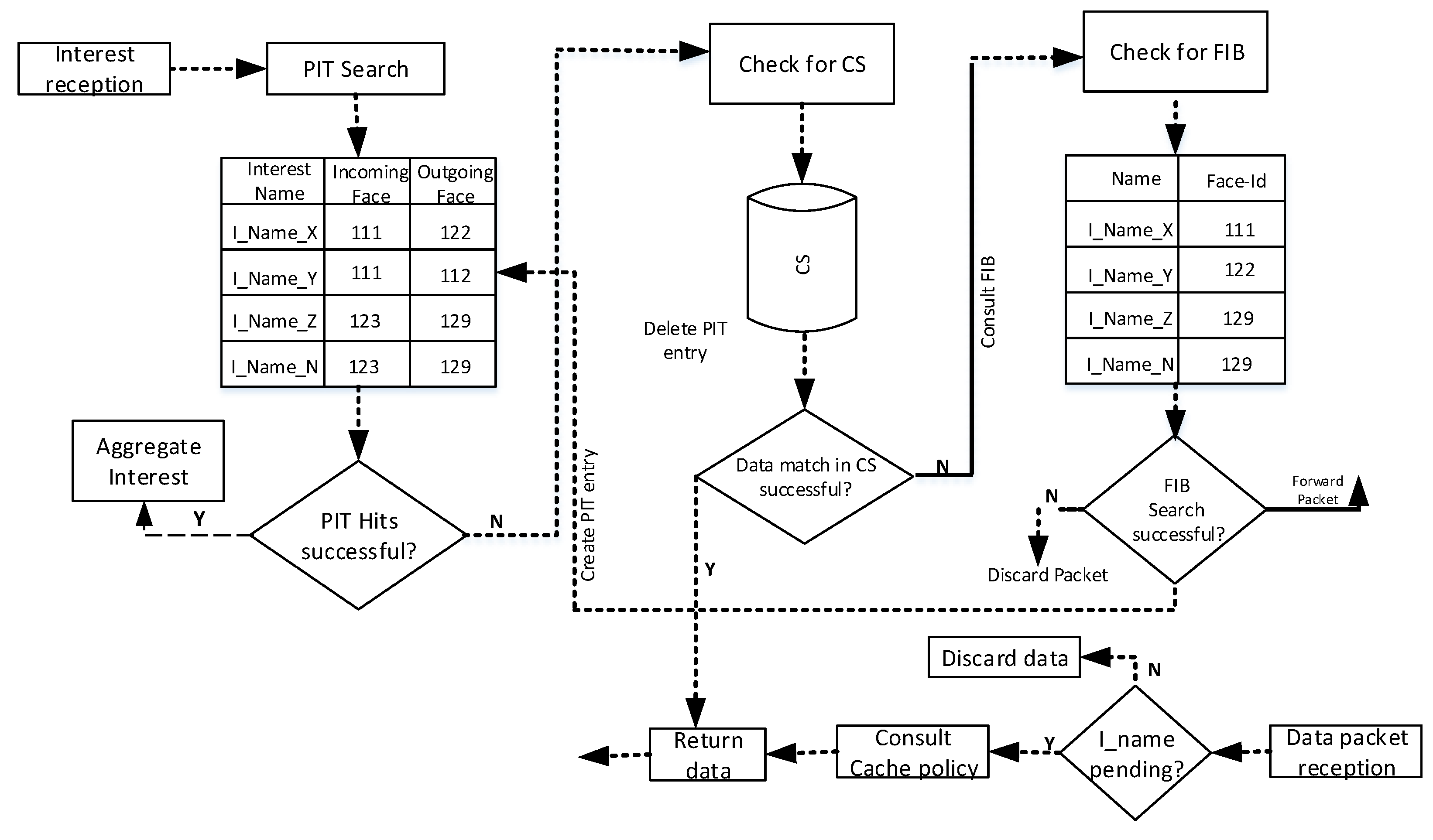
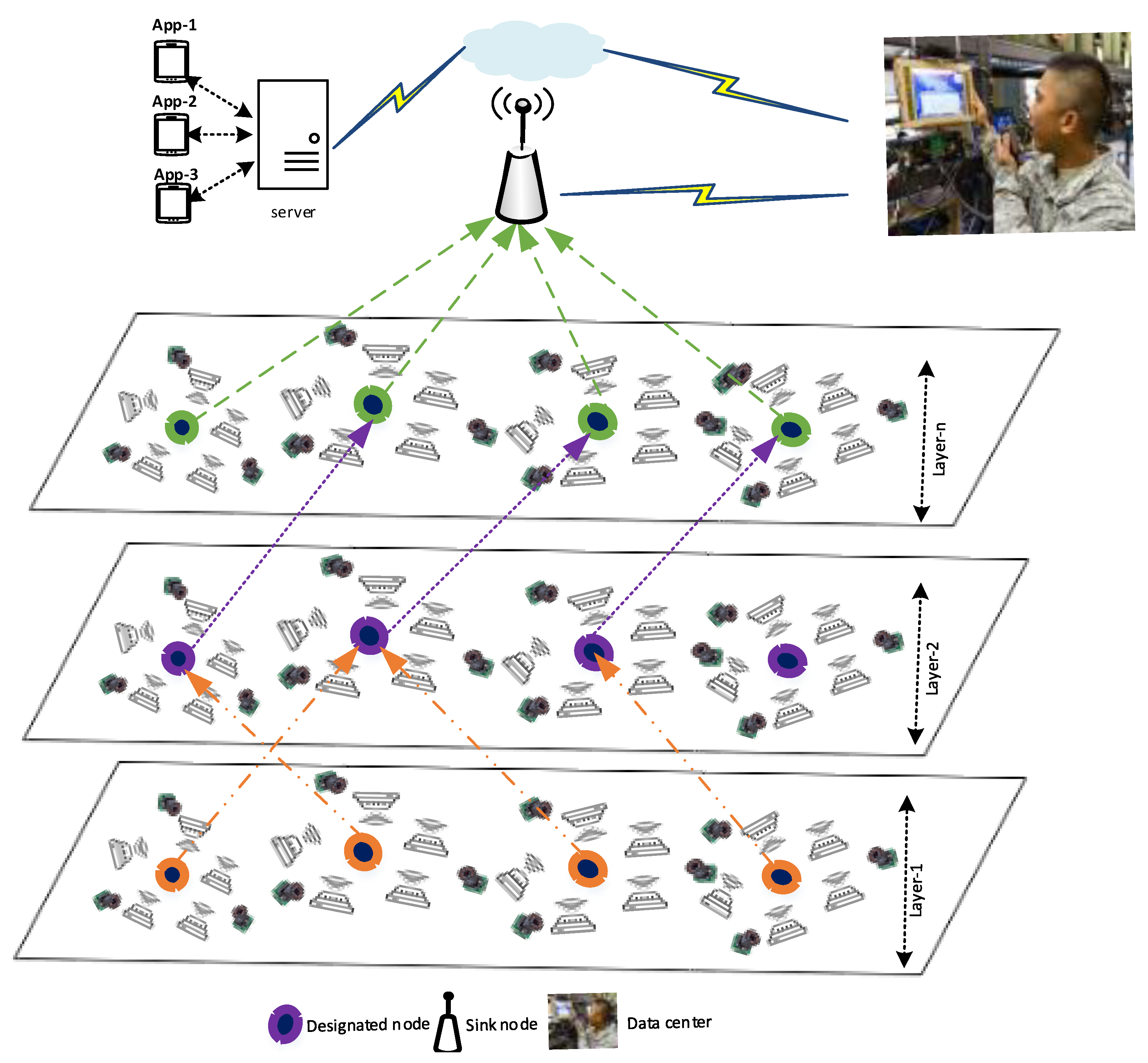
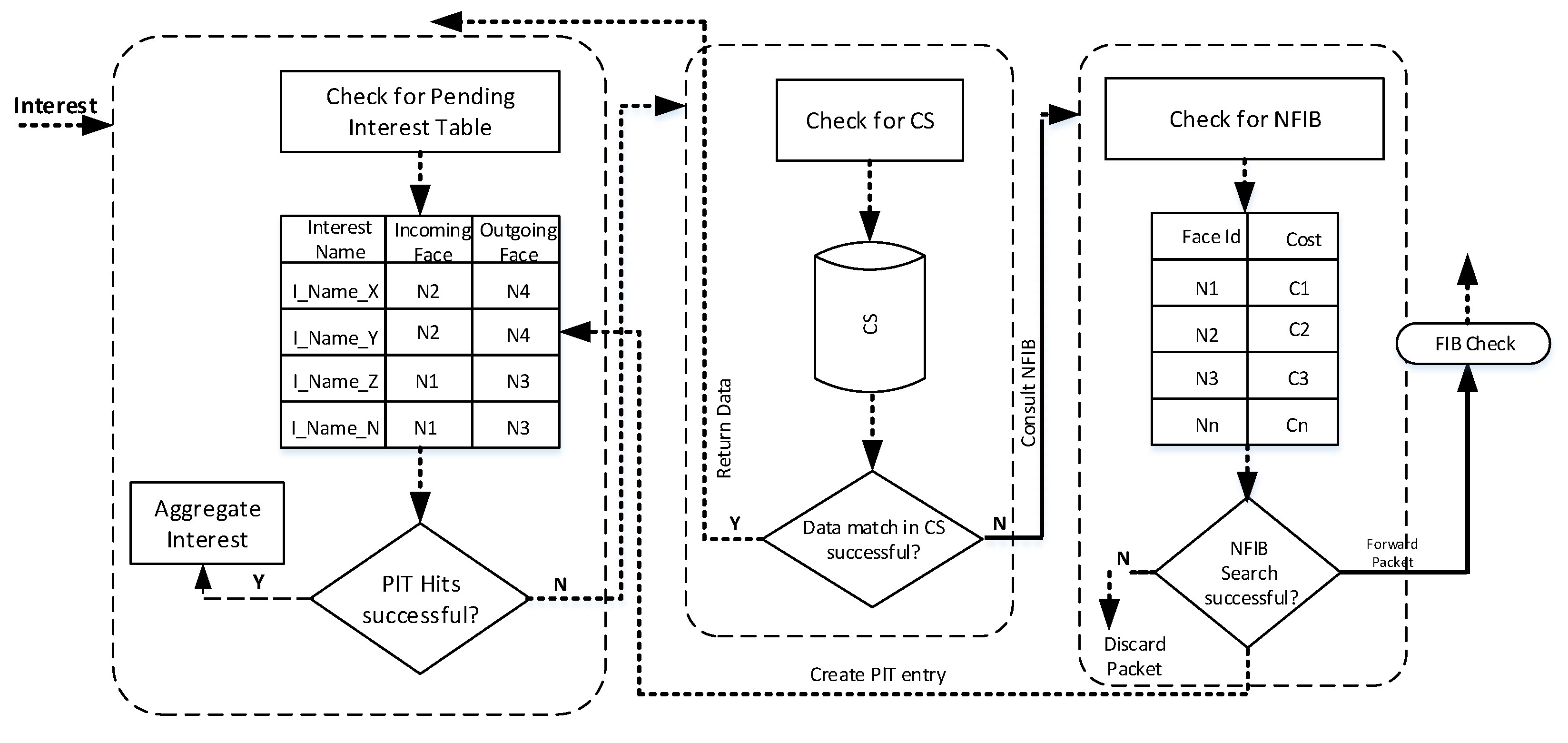
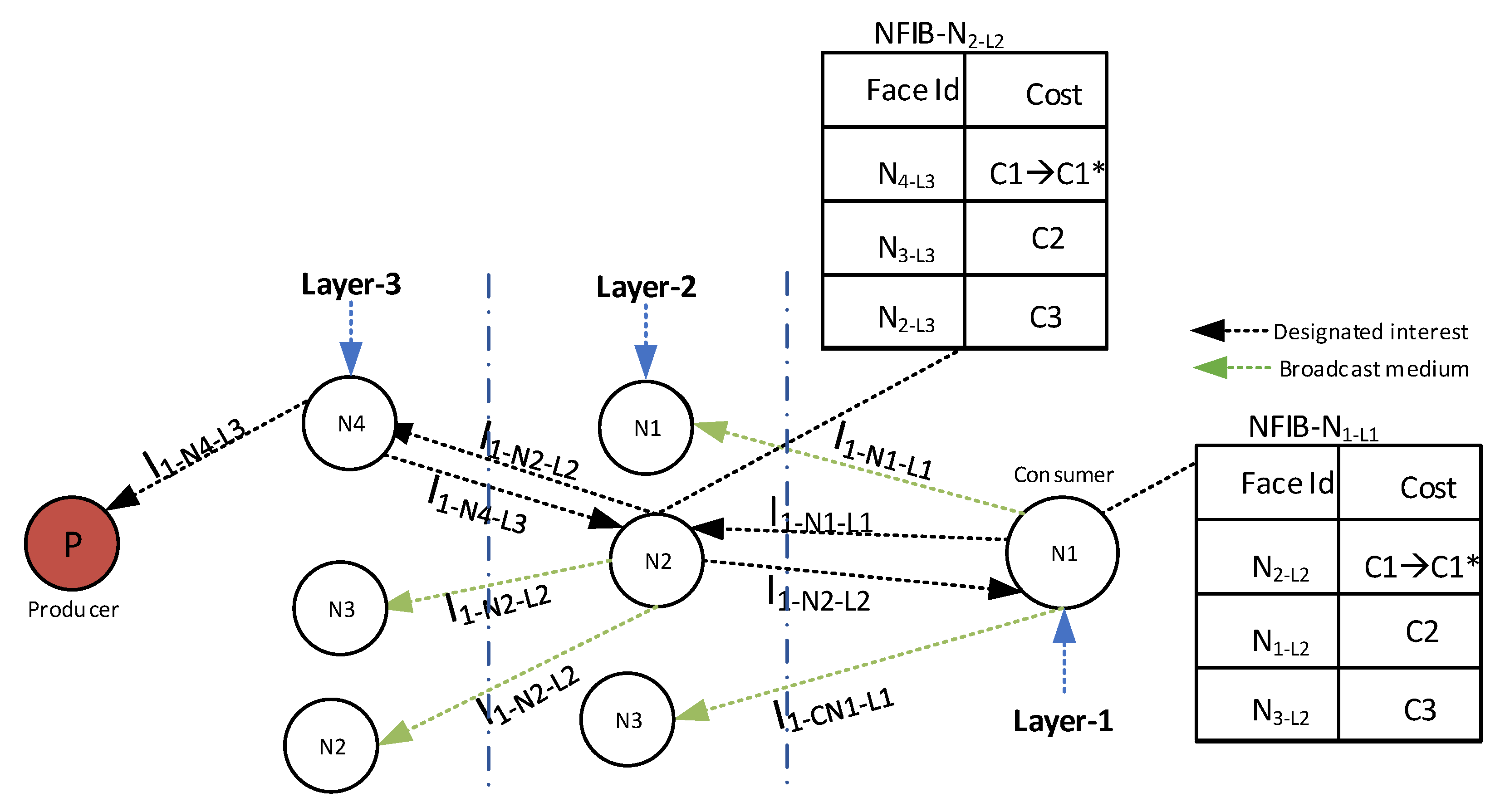
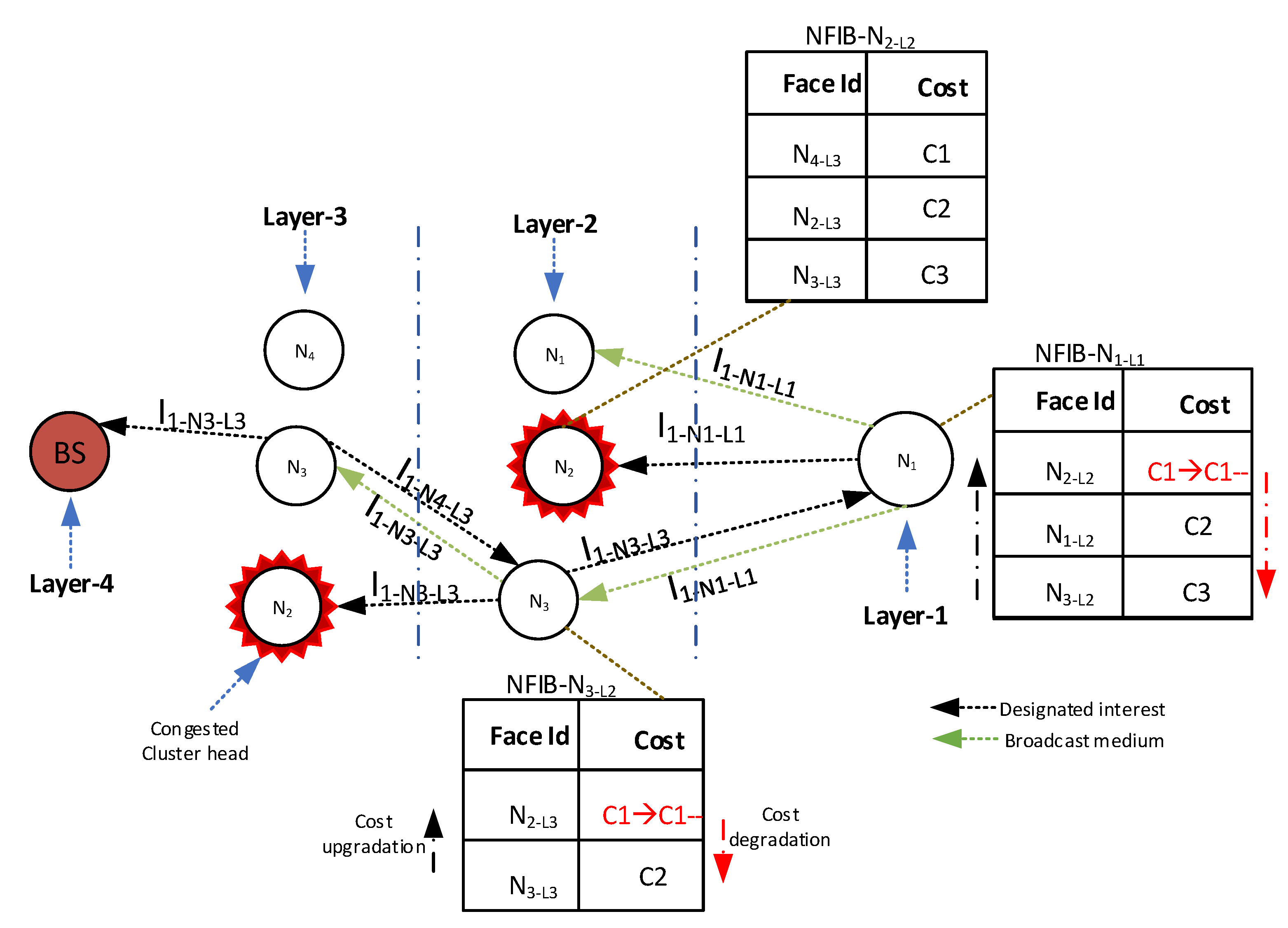
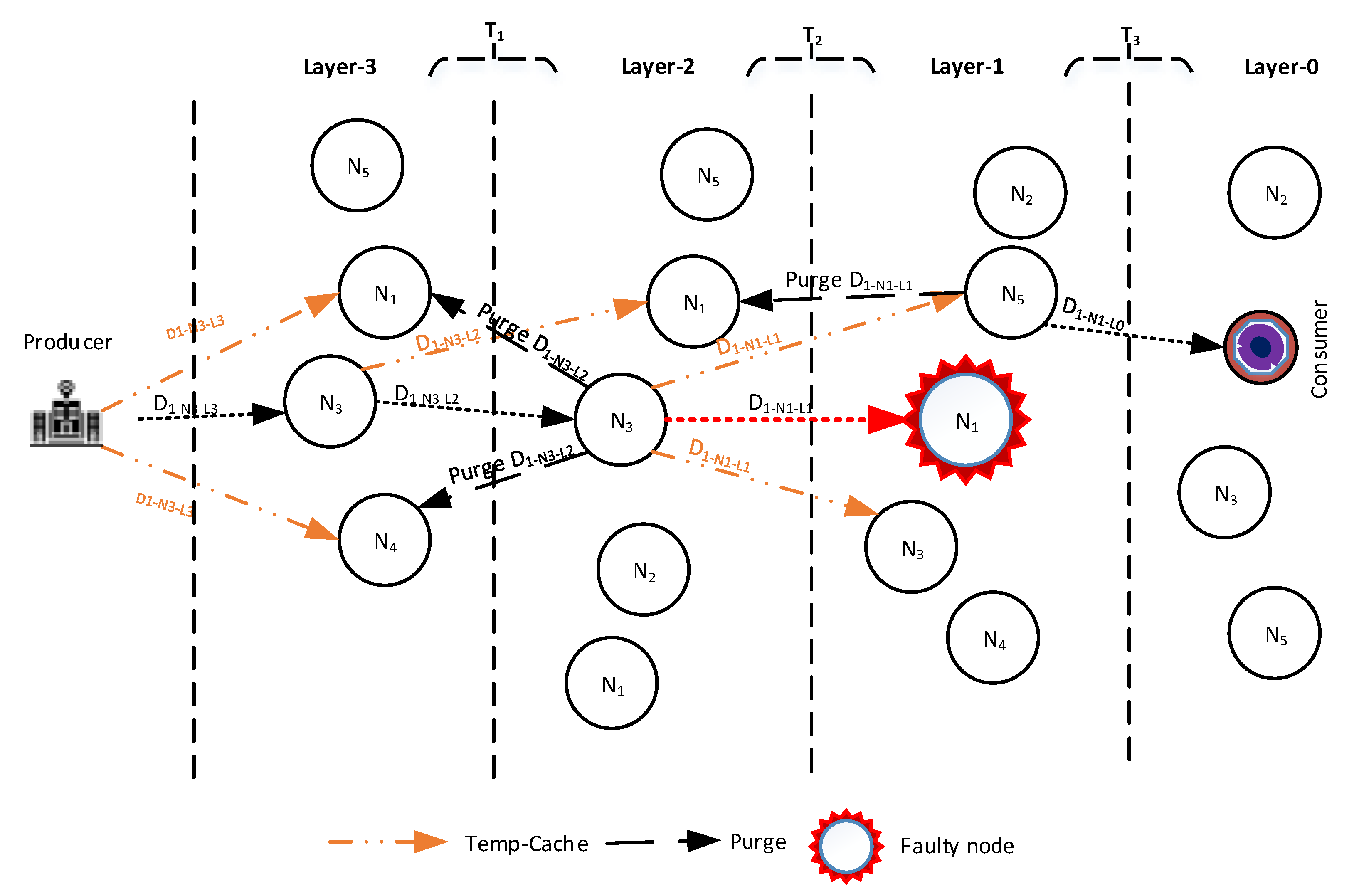

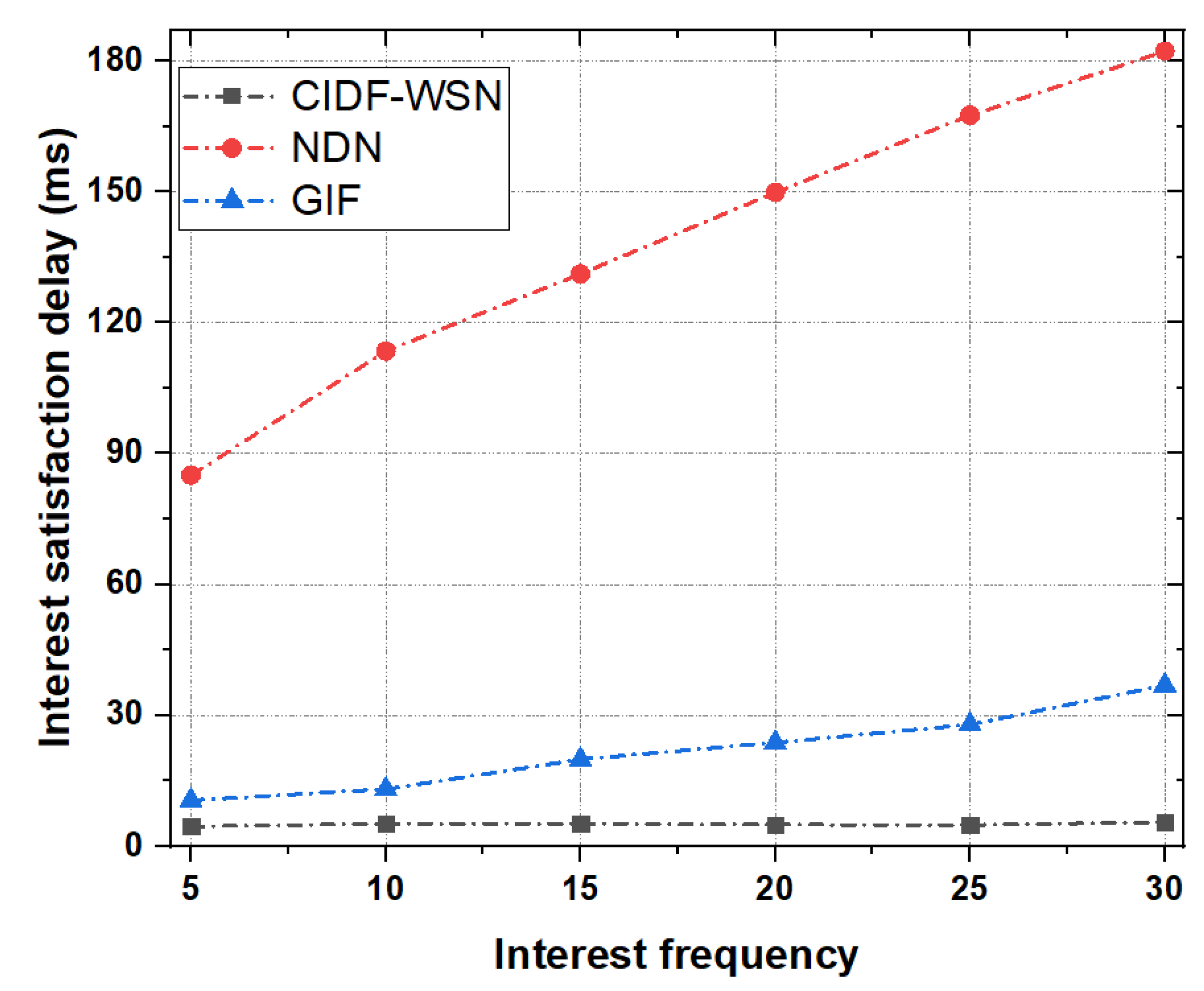



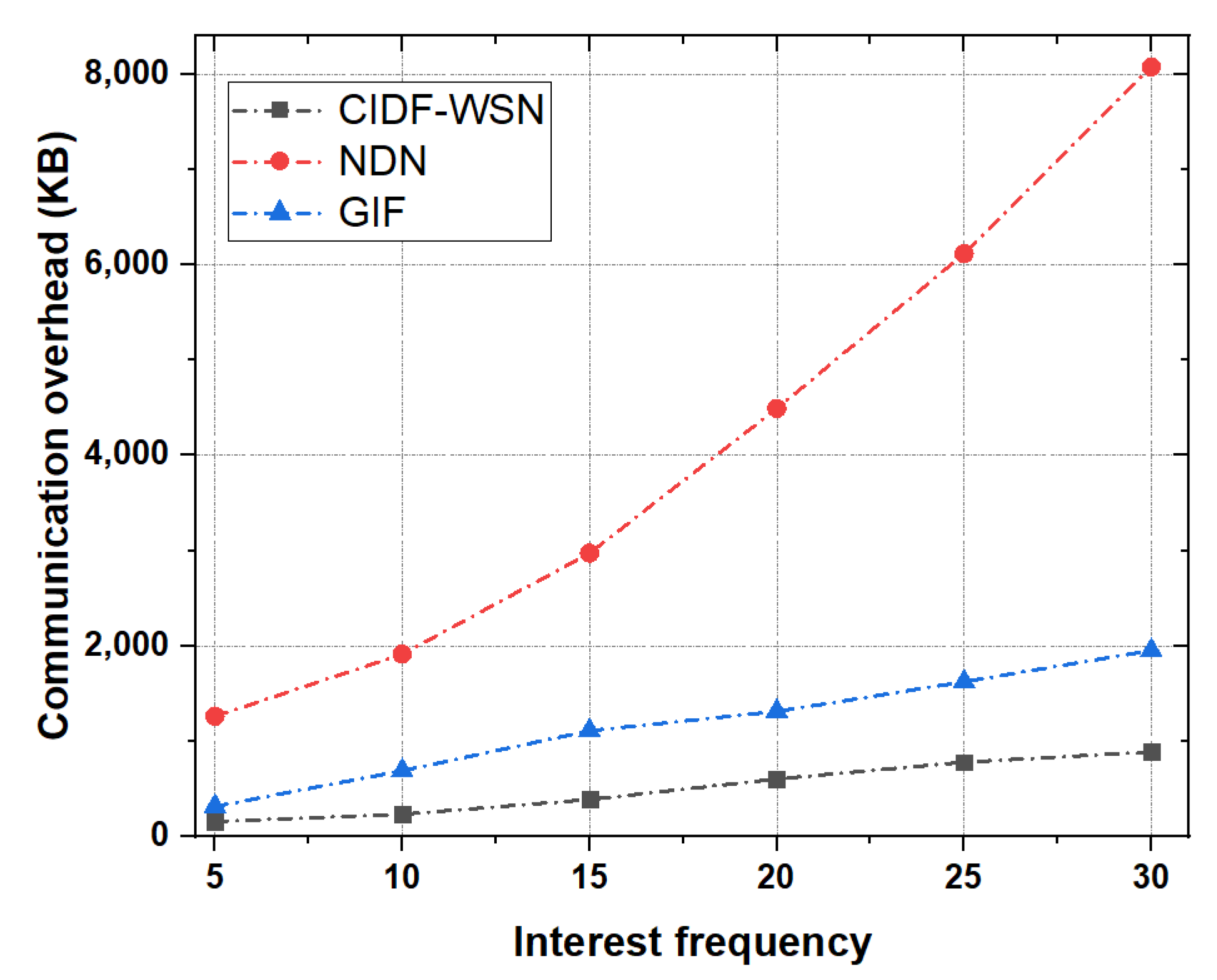
| Ref | Title | Packet Recovery | Downstream Processing | NFIB Update | Layer Arch |
|---|---|---|---|---|---|
| [21] | CCN-WSN | × | × | × | × |
| [22] | DMIF | ✓ | × | ✓ | × |
| [23] | BLOOGO | × | × | ✓ | × |
| [24] | CCN Caching | × | × | × | × |
| [25] | Muti source DataRetrieval | ✓ | × | × | × |
| [26] | NETWRAP | × | × | × | × |
| [27] | GIF | ✓ | × | ✓ | × |
| Proposed | CIDF-WSN | ✓ | ✓ | ✓ | ✓ |
| Parameter | Value |
|---|---|
| Simulator | NS-3 (ndnSIM 2.5) |
| Area | 100 × 100 |
| Total number of sensor nodes | 100 |
| Node distribution | layered distribution |
| Communication stack | NDN |
| Wireless interface | IEEE 802.15.4 |
| Propagation delay model | Constant Speed Propagation Delay Model |
| Energy consumption | 0.5 J/bit |
| PIT Timer | 4 sec |
| Interest Packet size | 48 bytes |
| Data Packet size | 96 bytes |
| Simulation time | 1800 sec |
Publisher’s Note: MDPI stays neutral with regard to jurisdictional claims in published maps and institutional affiliations. |
© 2021 by the authors. Licensee MDPI, Basel, Switzerland. This article is an open access article distributed under the terms and conditions of the Creative Commons Attribution (CC BY) license (https://creativecommons.org/licenses/by/4.0/).
Share and Cite
din, M.S.u.; Rehman, M.A.U.; Kim, B.-S. CIDF-WSN: A Collaborative Interest and Data Forwarding Strategy for Named Data Wireless Sensor Networks. Sensors 2021, 21, 5174. https://doi.org/10.3390/s21155174
din MSu, Rehman MAU, Kim B-S. CIDF-WSN: A Collaborative Interest and Data Forwarding Strategy for Named Data Wireless Sensor Networks. Sensors. 2021; 21(15):5174. https://doi.org/10.3390/s21155174
Chicago/Turabian Styledin, Muhammad Salah ud, Muhammad Atif Ur Rehman, and Byung-Seo Kim. 2021. "CIDF-WSN: A Collaborative Interest and Data Forwarding Strategy for Named Data Wireless Sensor Networks" Sensors 21, no. 15: 5174. https://doi.org/10.3390/s21155174
APA Styledin, M. S. u., Rehman, M. A. U., & Kim, B.-S. (2021). CIDF-WSN: A Collaborative Interest and Data Forwarding Strategy for Named Data Wireless Sensor Networks. Sensors, 21(15), 5174. https://doi.org/10.3390/s21155174







